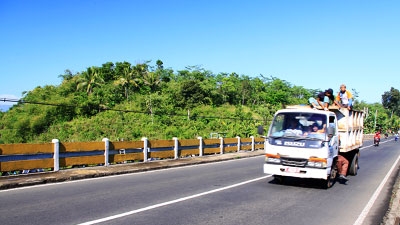- Road vehicles are the predominant mode of transport in Indonesia. The total classified road network is reportedly more than 477,000 km long, and worth more than 15% of Indonesia’s GDP. But the availability and quality of Indonesia’s road infrastructure remain below its regional peers.
- The Government of Indonesia has increased road infrastructure expenditure to IDR70 trillion/year (USD7.0 billion/year), accounting for 40% of total spending for infrastructure.
- After a steep decline in the late 1990s, road investment has returned to 1.6 per cent of GDP, the same amount before the 1999 financial crisis.
- However, this level of investment no longer keeps pace with the increasing demand and increasing growth of the past decade.
- The management of roads remains sub-optimal. Spending on national roads has increased by three fold between 2005 and 2011, but has only led to a 20% output increase in terms of roads preserved and developed.
- The costs of maintaining roads have increased and are high when compared to international norms. While many countries have now contracted out most of their routine maintenance works, Indonesia still uses an own-managed approach (known as ‘force account’, or swakelola. Hence, the unit cost of routine maintenance in Indonesia is relatively high. From 2005 to 2011, the national road network was mostly extended through the re-classification of 8,000 km of main roads, especially through minor widening of strategically located roads. But these efforts will not further the goal of developing a high-standard arterial network that will best meet the needs of the economy.
- The policy of providing minor capacity expansion on trunk routes may not be an optimal use of development funds. What is needed is a widening of roads to four lanes, and a separate integral expressway network where appropriate.
- Progress with expressway and toll road development has been exceedingly slow. Some highway concessions have not reached financial closure, even after 10 years have elapsed. By 2010, only 742 km of toll roads had been constructed and become operational, even though the first toll roads were built in 1978.
- The Government of Indonesia has made efforts to attract private sector participation in expressways development, but relies too much on Public Private Partnerships (PPPs) to bridge its funding gap. The project screening process, to ensure that the project is financially and economically viable, remains sub-optimal. Often the main motivation to establish PPPs is to close the funding gap, not to share risks.
- PPPs are complex and typically take many years to assemble. There are few roads outside the main arteries that are financially viable. There is a need to carry out a Value for Money (VFM) analysis to decide whether the project is better financed through the national budget, or by PPPs. When a project is economically viable but has borderline financial viability, it is better financed through a combination of public (Viability Gap Funding, VGF), private and/or donor financing.
- Lack of maintenance of sub-national roads is a serious concern as new, development takes priority over road maintenance. Adequate sub-national roads maintenance would require doubling the current spending level.
- Total revenues from revenues collected from taxes and levies related to vehicles and road users were estimated to be around Rp 31 trillion (US$3.0 billion) in 2009. There is a financial and a legal basis for the establishment of a Road Preservation Fund at the provincial level, but the linkage between road user charges and road maintenance is weak.
- Every US Dollar spent on road maintenance will generate USD4.6 in road user cost savings. It is estimated that if the financing is to come from the fuel levy (a tax on fuel consumption), the average fuel levy needed to cover the 5-year sub-national road maintenance backlog requirements, including rehabilitation work is IDR532/liter (5.32USc/liter), and IDR156/litre (1.5 USc/liter) thereafter.
- Road user charges can potentially cover more than three-quarters of the annual maintenance and rehabilitation needs of sub-national roads. There is an urgent need to phase out the fuel subsidy in order to be able to reallocate spending more effectively. The average fuel levy needed to cover the 5 year expressway and arterial roads program is IDR 1,100/liter (11.0 US c/liter).

